Suchen Sie nach einer WP Delicious-Bewertung, die Ihnen bei der Entscheidung hilft, ob es das richtige Rezept-Plugin für Ihre WordPress-Website ist?
WP Delicious ermöglicht es Ihnen, eine unbegrenzte Anzahl von SEO-optimierten Rezeptkarten mit Schritt-für-Schritt-Anleitungen, Fotos, Videos und Nährwertangaben zu veröffentlichen. Ihre Leser können diese Rezepte bewerten oder sogar eigene Vorschläge einreichen, die auf Ihrer Website veröffentlicht werden.
In dieser WP Delicious-Bewertung werden wir dieses beliebte Plugin untersuchen, um zu sehen, ob es das Richtige für Sie ist.
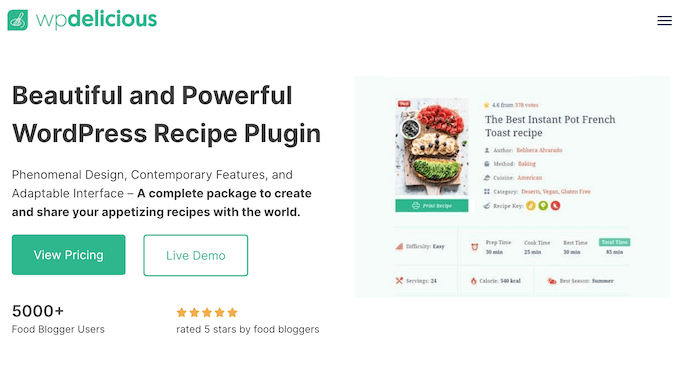
WP Delicious Test: Warum es in WordPress verwenden?
WP Delicious ermöglicht es Ihnen, schöne, Schema-fähige Rezeptkarten zu Ihrer Website hinzuzufügen. Es verfügt über einen benutzerfreundlichen Builder und mehrere Layout-Optionen, darunter Raster, Liste und Karussell.
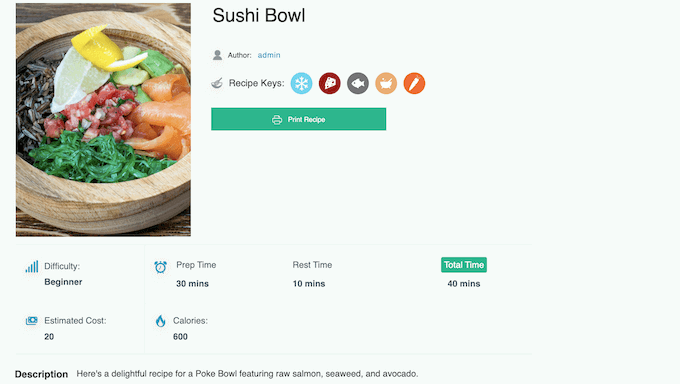
Mit WP Delicious können Sie sehr informative und detaillierte Karten erstellen, die einen Schwierigkeitsgrad, eine Zubereitungszeit, eine Kochzeit, eine Ruhezeit, geschätzte Kosten, die beste Jahreszeit und mehr enthalten. Dies kann Ihren Besuchern helfen, das perfekte Rezept für sie zu finden.
Weiterhin ermöglicht WP Delicious das Hinzufügen von Fotogalerien zur Karte und unterstützt sogar Affiliate-Links, sodass Sie online Geld verdienen können. Es bietet auch eine Vielzahl anderer Funktionen, darunter einstellbare Portionsgrößen, Nährwertangaben und ein integriertes Analyse-Dashboard.
Nach der Konfiguration von WP Recipes können sich Besucher auf Ihrer Website registrieren und Ihre Rezepte bewerten oder sie als 'Favoriten' markieren, damit sie immer leicht zugänglich sind. Dies kann Ihnen helfen, eine Community aufzubauen und mehr Interaktion auf Ihrem Food-Blog zu erzielen.
Wenn Sie gerade erst anfangen oder ein begrenztes Budget haben, können Sie WP Delicious lite von WordPress.org herunterladen.
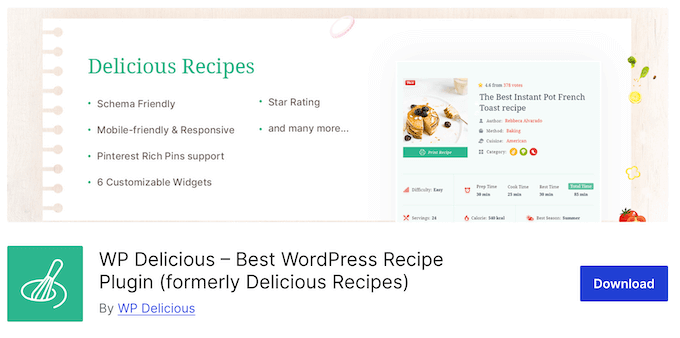
Dieses kostenlose Plugin ermöglicht es Ihnen, so viele Rezepte zu erstellen, wie Sie möchten, und fügt automatisch FAQ und Rezept-Schema zu Ihren Inhalten hinzu. Besucher können Ihre Rezepte auch bewerten und als 'Favoriten' markieren.
However, if you upgrade to the premium plugin then you’ll get access to extra features including additional layouts, built-in analytics, and a ‘related recipes’ section. You can also accept recipes from readers, and then publish the best ones on your WordPress blog.
WP Delicious Test: Ist es das richtige Rezept-Plugin für Sie?
Wenn Sie einen WordPress-Food-Blog haben, kann ein Rezept-Plugin Ihre Inhalte in einem schönen Layout anzeigen, das alle Informationen enthält, die Leser benötigen, um großartiges Essen zu kochen. Dies kann das Leseerlebnis verbessern, was die Absprungrate reduzieren und die Leute dazu bringen wird, wiederzukommen.
Mit diesen Worten wollen wir sehen, ob WP Delicious das richtige Rezept-Plugin für Sie ist.
1. Einfach zu bedienen
WP Delicious wurde mit Blick auf Benutzerfreundlichkeit entwickelt. Zunächst können Sie es wie jedes andere WordPress-Plugin installieren und aktivieren.
Nach der Aktivierung fügt WP Delicious einen neuen Bereich zum WordPress-Dashboard hinzu, in dem Sie beliebig viele Rezepte erstellen können. In diesem Editor können Sie detaillierte Informationen hinzufügen, einschließlich der benötigten Zutaten und Geräte, Schritt-für-Schritt-Anleitungen und eines Beitragsbildes.
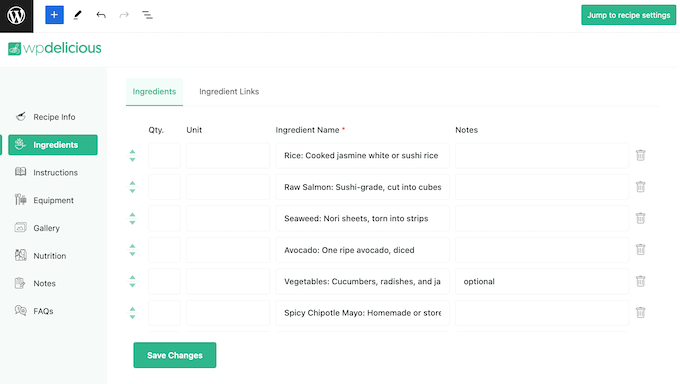
Sie können Besuchern auch helfen, dieses Rezept zu finden, indem Sie relevante Schlüsselwörter, Rezeptschlüssel, Taxonomien und mehr hinzufügen.
Wenn Sie mit der Einrichtung des Rezepts zufrieden sind, können Sie es mit dem Rezeptkarten-Block zu jeder Seite oder jedem Beitrag hinzufügen.
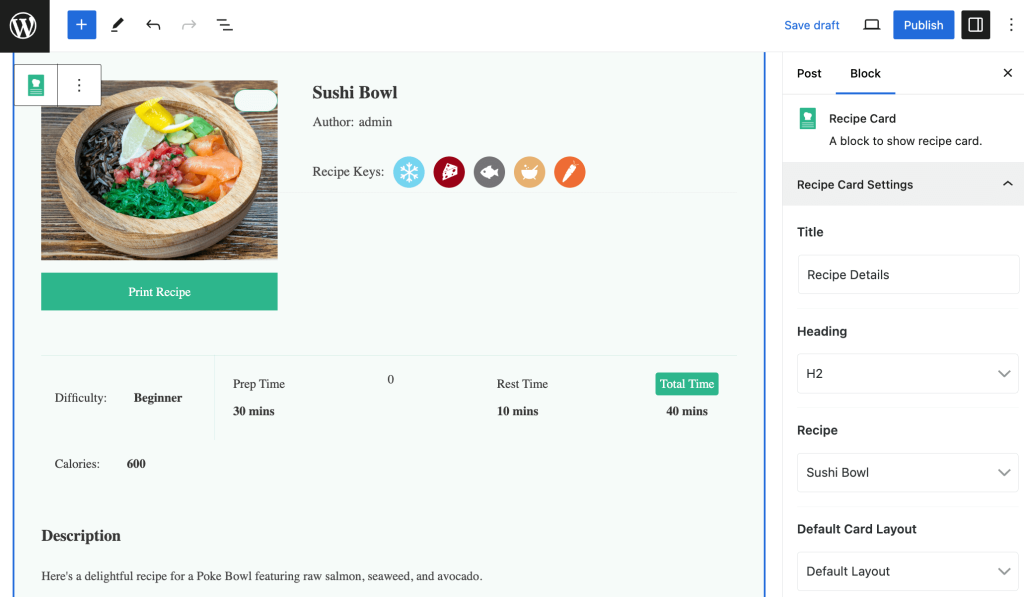
Another option is to create recipes on-the-fly, using the Dynamic Recipe Card.
Fügen Sie diesen Block einfach zu einer beliebigen Seite oder einem Beitrag hinzu und geben Sie dann die gewünschten Informationen ein.
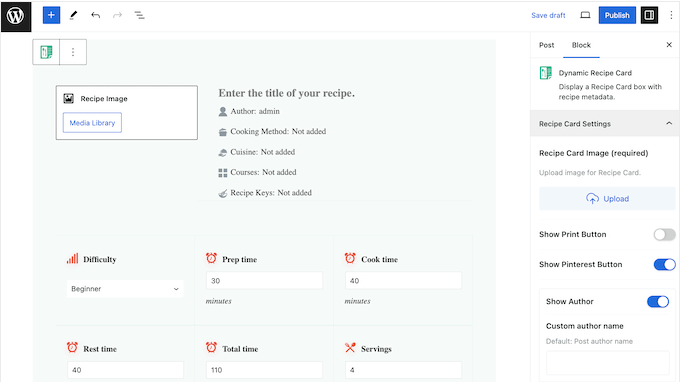
2. Wiederverwendbare Rezepte
WP Delicious bietet einen zentralen Ort, an dem Sie alle Ihre Rezepte erstellen können, ähnlich wie Sie Seiten und Beiträge entwerfen.
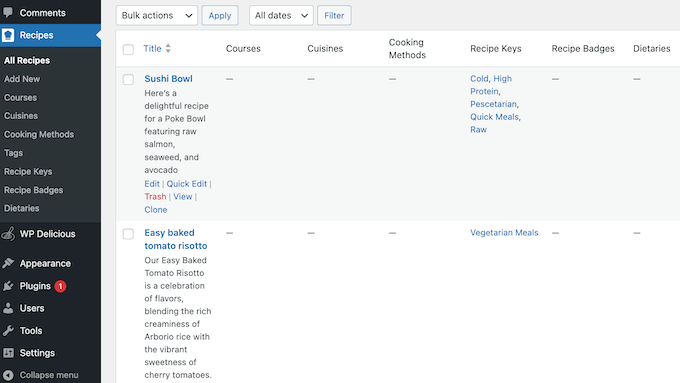
Nach der Erstellung eines Rezepts können Sie es mit der Rezeptkarte auf jeder Seite oder jedem Beitrag anzeigen. Auf diese Weise können Sie dasselbe Rezept an mehreren Stellen anzeigen, ohne es jedes Mal manuell neu erstellen zu müssen.
If you need to make some changes, then you can simply edit the source recipe. WP Delicious will then update each instance of that recipe automatically, saving you even more time and effort.
3. Anpassbare Rezeptlayouts
Wenn Sie das kostenlose WP Delicious-Plugin verwenden, können Sie zwischen drei verschiedenen Rezeptkartenlayouts wählen. Wenn Sie jedoch auf das Premium-WP Delicious-Plugin upgraden, erhalten Sie Zugriff auf 8 verschiedene Layouts.
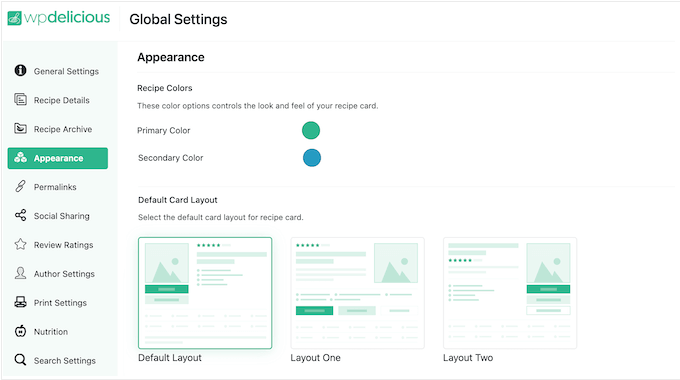
Unabhängig davon, für welches Layout Sie sich entscheiden, WP Delicious ist vollständig anpassbar, sodass Sie Ihre eigenen benutzerdefinierten Einheiten, Farbschemata und sogar die Permalinks zu Ihrer bevorzugten URL-Struktur ändern können.
Sie können auch benutzerdefinierte Symbole für Ihre Rezeptschlüssel, Kochmethoden und Rezept-Tags hochladen.
Darüber hinaus verfügt WP Delicious über mehrere Blöcke, die spezifische Arten von Rezeptinhalten zu einer Seite oder einem Beitrag hinzufügen. Zum Beispiel gibt es einen Block für Rezeptzutaten, der eine Zutatenliste hinzufügt.
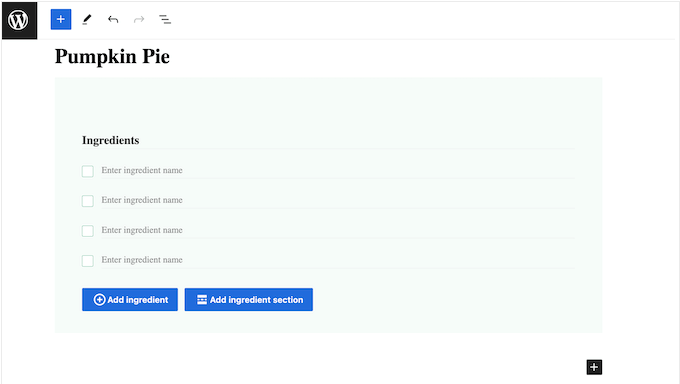
Es gibt auch einen Rezept-Buttons-Block, der die Schaltflächen „Zum Rezept springen“, „Zum Video springen“ und „Rezept drucken“ zur Seite oder zum Beitrag hinzufügt.
Dies ermöglicht Ihnen, genau zu steuern, welche Rezeptinhalte Sie zu jeder Seite hinzufügen und in welcher Reihenfolge diese Inhalte erscheinen. Durch die Kombination dieser Blöcke auf verschiedene Weise und ihre sorgfältige Positionierung auf der Seite können Sie alle Arten von benutzerdefinierten Layouts erstellen.
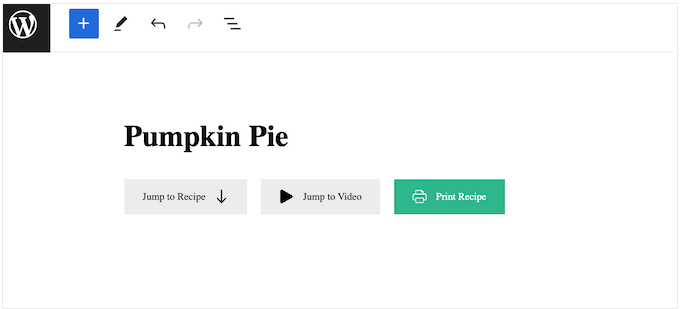
Sie können diese Blöcke auch mit normalem Text kombinieren. Zum Beispiel könnten Sie Ihre Schritt-für-Schritt-Anleitungen als regulären Blogbeitrag schreiben und formatieren und dann WP Delicious-Blöcke wie Rezeptzutaten und Rezept-Buttons als zusätzlichen Inhalt verwenden.
4. Rezeptsyntax
Alle WP Delicious-Rezepte sind für Google Structured Data optimiert und enthalten die Recipe-Schema-Markup. Dieses Recipe-Schema-Markup ist eine spezielle Art von HTML-Code , der Suchbots mehr Informationen über Ihre Rezepte liefert. Dies hilft den Suchmaschinen, Ihre Inhalte zu verstehen und sie Lesern anzuzeigen, die genau nach dieser Art von Inhalten suchen.
Noch besser, Suchmaschinen wie Google verwenden dieses Schema-Markup, um Featured Snippets zu erstellen. Diese erscheinen ganz oben in den Suchergebnissen und enthalten zusätzliche Informationen. Zum Beispiel könnte Google die Zutaten, die Sternebewertung, die Kochzeit, den Nährwert und andere Informationen Ihres Rezepts als Featured Snippet anzeigen.
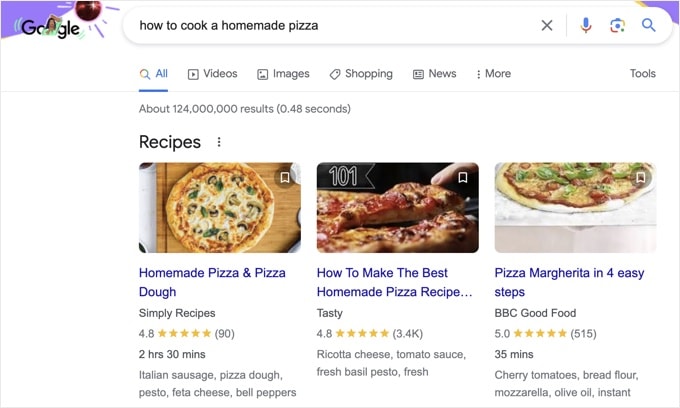
Dies wird Ihre Rezepte sofort in den Suchergebnissen hervorheben und wahrscheinlich den Traffic auf Ihrem WordPress-Blog erhöhen. Dieses Schema-Markup bedeutet auch, dass Ihre Rezepte als Rich Recipe Pins angezeigt werden, wenn sie auf Pinterest geteilt werden.
5. FAQ-Schema
Ähnlich wie beim Rezept-Schema kann FAQ-Schema Suchmaschinen helfen, Ihre Inhalte zu verstehen und sie richtig zu indizieren.
Darüber hinaus ermutigt das FAQ-Schema Suchmaschinen wie Google, Ihre Fragen und Antworten in seinen SERPs anzuzeigen. Auch dies lässt Ihre Inhalte unter all den konkurrierenden Ergebnissen hervorstechen. Mit WP Delicious können Sie eine FAQ-Sektion und ein Schema zu Ihren Rezeptkarten hinzufügen.
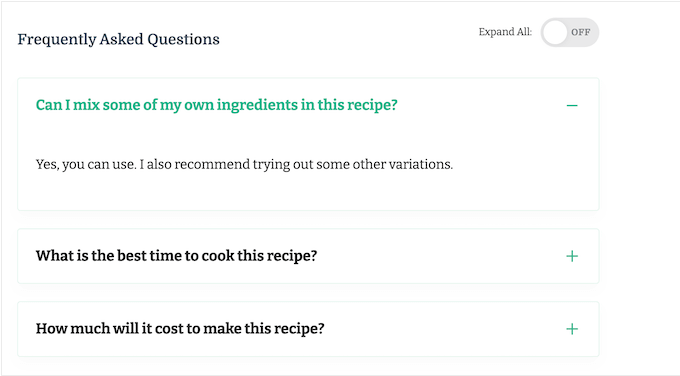
Dies kann einige nützliche Zusatzinformationen liefern und gleichzeitig Ihre Beiträge für SEO optimieren.
6. Für Suchmaschinen optimieren
Über das Schema hinaus ermöglicht der WP Delicious-Editor das Hinzufügen relevanter Schlüsselwörter und Metadaten zu jedem Rezept. Dies wird auch Ihre WordPress SEO verbessern, indem Suchmaschinen noch mehr Informationen über das Rezept erhalten.
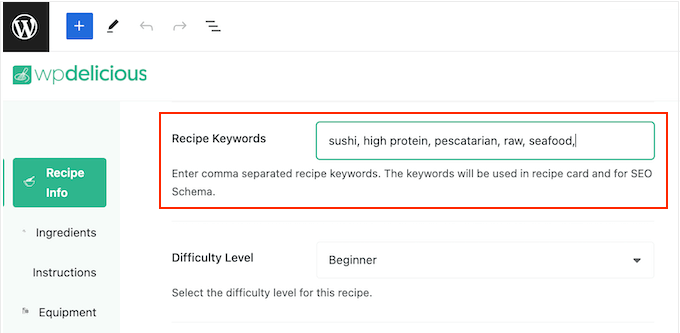
Schließlich lässt sich WP Delicious nahtlos in Rank Math integrieren, sodass Sie Ihre Rezepte mit diesem beliebten WordPress SEO-Plugin analysieren und optimieren können.
7. Autorenprofil
Mit WP Delicious können Sie Ihren Rezeptkarten ein Autorenprofil hinzufügen. Diese Profile können detaillierte Informationen sowie Links zu den verschiedenen Social-Media-Konten des Autors enthalten. Das bedeutet, dass sie dazu beitragen können, Ihre sozialen Follower zu vergrößern.
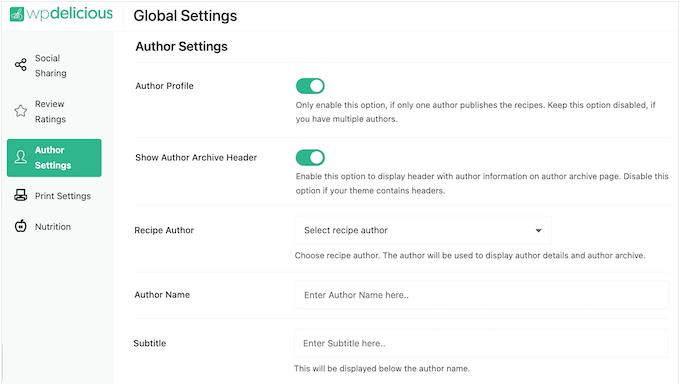
8. Nährwertangaben hinzufügen
Nährwertangaben helfen den Lesern, fundiertere Entscheidungen über die von ihnen gekochten Mahlzeiten zu treffen. Sie können Ihre Food-Website auch ansprechender gestalten, insbesondere im Vergleich zu Rezept-Blogs, die keine Nährwertinformationen enthalten.
Mit WP Delicious können Sie jedem Rezept Nährwertangaben hinzufügen, einschließlich Kalorien, Vitamine und Nährstoffe. Sie können auch die Portionsgröße und die Anzahl der Portionen anpassen.
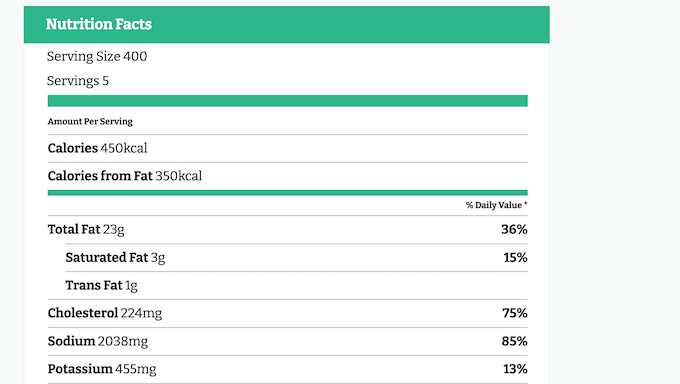
Wenn dies geschehen ist, zeigt WP Delicious diese Informationen als Nährwertkennzeichnung an.
In den Einstellungen des Plugins können Sie zwischen zwei verschiedenen Beschriftungsstilen wählen und zusätzliche Nährstoffe hinzufügen, die Sie verwenden möchten.
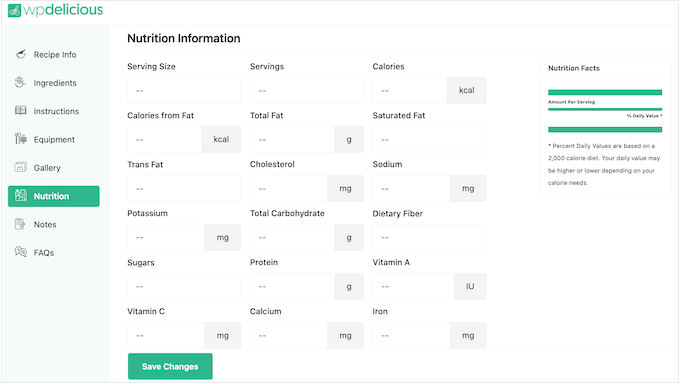
9. Bildergalerie und Lightbox
Wenn sie nach einem Rezept suchen, schauen die meisten Leser zuerst auf die Fotos des Rezepts.
Appetitlich aussehende Fotos sind ein Muss für jede Food-Website, und WP Delicious ermöglicht es Ihnen, noch einen Schritt weiter zu gehen, indem Sie jeder Rezeptur Galerien hinzufügen.
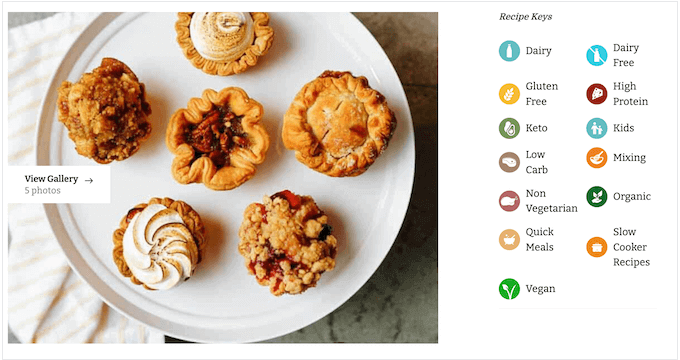
Sie können diese Bilder auch in einem Lightbox-Fenster anzeigen lassen, das über der Seite oder dem Beitrag erscheint, damit die Leser sie genauer betrachten können.
10. Unterstützung für Videogalerien
Einige Besucher ziehen es vielleicht vor, ein Video anzusehen, anstatt Schritt-für-Schritt-Anleitungen zu lesen. Wenn Sie also ein Video-Tutorial erstellt haben, können Sie es zu Ihrer Rezeptkarte hinzufügen.
Dies ermöglicht es Besuchern, auf Ihre Rezepte so zuzugreifen, wie es für sie am besten funktioniert. Dies bietet ein wesentlich besseres Erlebnis im Vergleich zu alternativen Rezept-Websites, die nur Textanweisungen anbieten.
11. Rezeptschlüssel
Schlüssel sind kleine Symbole, die oben auf der Rezeptkarte angezeigt werden, damit Besucher diese Mahlzeit auf einen Blick kennenlernen können.
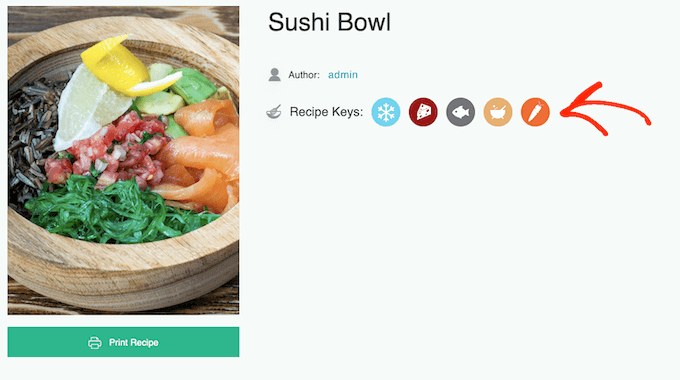
WP Delicious verfügt über eine Reihe integrierter Rezeptschlüssel, die Sie verwenden können, wie z. B. milchfrei, eifrei, Keto, Bio und Rohkost.
All diese Standard-Schlüssel sind vollständig anpassbar, sodass Sie beliebige Änderungen vornehmen können.
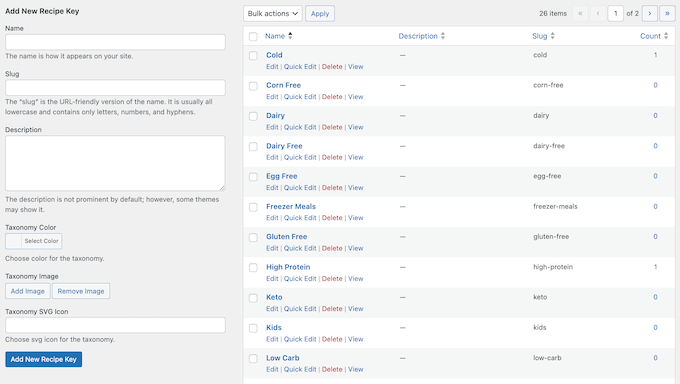
Sie können auch Ihre eigenen Schlüssel erstellen und benutzerdefinierte Symbole hochladen.
12. Pinterest und Instagram Teilen
Food-Fotos und Inhalte sind auf Social-Media-Plattformen sehr beliebt. Vor diesem Hintergrund möchten Sie es den Lesern erleichtern, Ihre Rezepte in sozialen Medien zu teilen.
With WP Delicious, visitors can easily share your posts to Instagram and Pinterest.
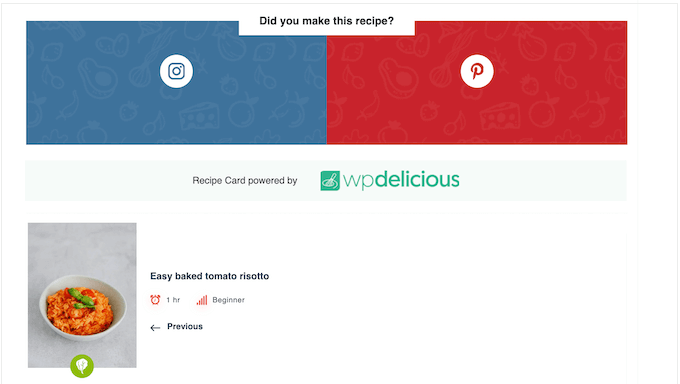
Insbesondere formatiert WP Delicious Ihre Rezepte so, dass sie als Recipe Rich Pins angezeigt werden, wenn sie auf Pinterest geteilt werden. Dies kann Ihre Sichtbarkeit und Klickraten auf Pinterest verbessern.
13. Rezepte skalieren
Beim Erstellen eines Rezepts können Sie die Portionsgröße und die Portionsmenge angeben. WP Delicious kann diese Informationen auch verwenden, um das Rezept für eine andere Anzahl von Portionen zu skalieren.
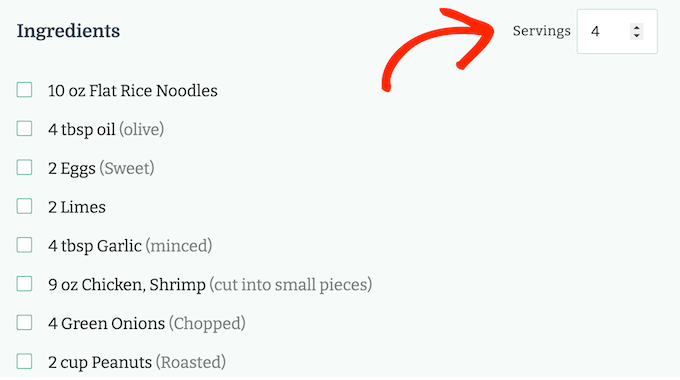
Dies beseitigt das Rätselraten und macht Ihre Rezepte leicht verständlich, unabhängig davon, für wie viele Personen der Leser kocht.
14. Ähnliche Rezepte anzeigen
Wenn Sie auf das Premium-Plugin upgraden, erhalten Sie Zugriff auf eine Funktion für Inline-verwandte Beiträge. Wenn diese aktiviert ist, fügt WP Delicious automatisch verwandte Beiträge zu Ihren Rezeptbeiträgen hinzu.
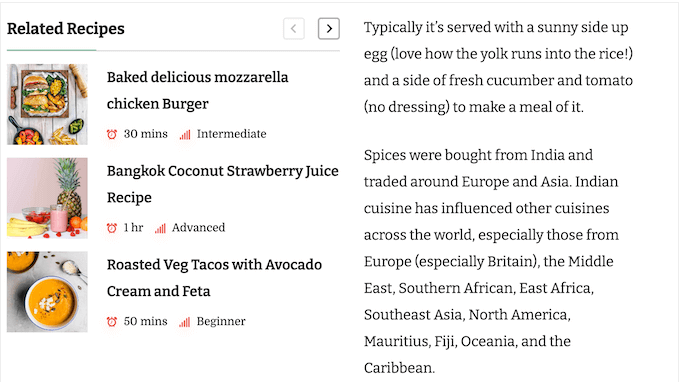
In den Plugin-Einstellungen können Sie konfigurieren, wie viele Rezepte im Abschnitt enthalten sein sollen, die Überschrift ändern und Inhalte basierend auf der Taxonomie filtern.
15. Rezept-Widgets
WP Delicious verfügt über eine Reihe von Widgets, die Sie zu den Widget-Bereichen Ihres WordPress-Themes hinzufügen können: Ausgewählte Rezepte, Rezept-Tags, Rezept-Kategorien, Beliebte Rezepte, Neueste Rezepte und Rezept-Schlüssel.
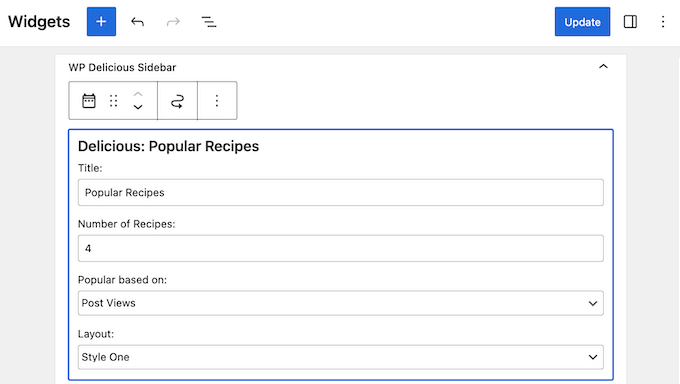
Diese WordPress-Widgets bieten Besuchern zusätzliche Möglichkeiten, Ihre Inhalte zu erkunden, und können auch Ihre Rezepte bewerben, ohne vom Hauptseiteninhalt abzulenken.
16. Rezepte leicht finden
WP Delicious enthält eine Rezeptindex-Seite, die alle Ihre Rezepte auflistet. Dies erleichtert es den Lesern, Ihre veröffentlichten Inhalte zu durchsuchen und das perfekte Rezept für sie zu finden.
WP Delicious bietet auch eine erweiterte Suche, damit Leser Rezepte einfach filtern und finden können. Diese Suche unterstützt die 'UND'-Logik, sodass Leser sehr spezifische Suchkriterien erstellen können.
Alternativ können Sie Rezepte nach ihrer Taxonomie oder ihrem Begriff mit dem Block Rezepte nach Taxonomie anzeigen. Auf diese Weise können Sie kuratierte Rezeptlisten erstellen und dann genau steuern, wo sie auf Ihrer Website erscheinen. Sie könnten beispielsweise bestimmte Rezepte zu einer bestimmten Landingpage hinzufügen oder einen benutzerdefinierten Abschnitt 'Ähnliche Rezepte' erstellen.
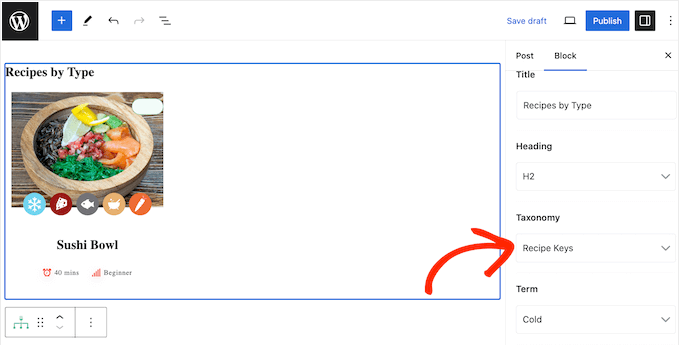
17. Vorgefertigte Shortcodes
WP Delicious wird mit einer Reihe von Shortcodes geliefert, die Sie zum Anzeigen Ihrer Rezepte verwenden können. Sie können diese Shortcodes verwenden, um Ihre neuesten Rezepte in einem Karussell, einer Liste oder einem Rasterlayout anzuzeigen.
Nachdem Sie sich für einen Shortcode entschieden haben, können Sie ihn zu jeder Seite, jedem Beitrag oder jedem Widget-fähigen Bereich hinzufügen, und WP Delicious kümmert sich um den Rest.
Weitere Informationen finden Sie in unserem Leitfaden zum Hinzufügen eines Shortcodes in WordPress.
18. Schwebende Rezeptleiste
WP Delicious can add a floating bar to your posts. This provides easy access to some useful features, such as the option to print your recipe, share it on social media, or add to their ‘Favorites’ list.
Besucher können auch den Modus "Fokussiertes Lesen" aktivieren oder einen Timer starten, während sie das Rezept zubereiten.
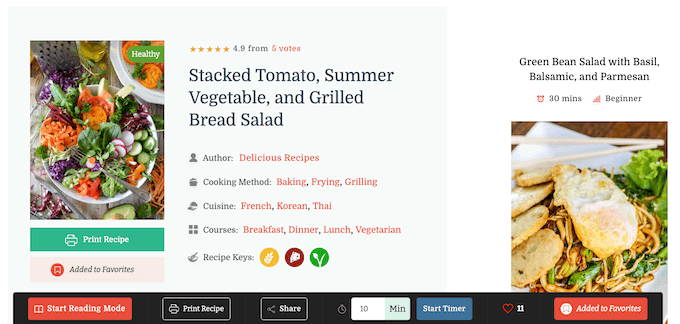
19. Rezepte automatisch laden
Wenn der Leser das Ende eines Beitrags erreicht, kann WP Delicious automatisch ein weiteres Rezept laden. Dies ermutigt den Besucher, weiterzulesen oder Ihren Inhalt zu durchsuchen und zusätzliche Rezepte zu entdecken, die er vielleicht ausprobieren möchte.
20. Anpassbare Druckseite
Einige Leser möchten vielleicht Ihre Rezepte ausdrucken. In diesem Fall können Sie mit WP Delicious anpassen, wie die Druckseite für Rezepte aussieht.
Sie können genau auswählen, welche Informationen auf der gedruckten Seite enthalten sein sollen, Ihr Website-Logo hinzufügen und sogar zusätzlichen Text und einen gedruckten Link zum Originalrezept einfügen.
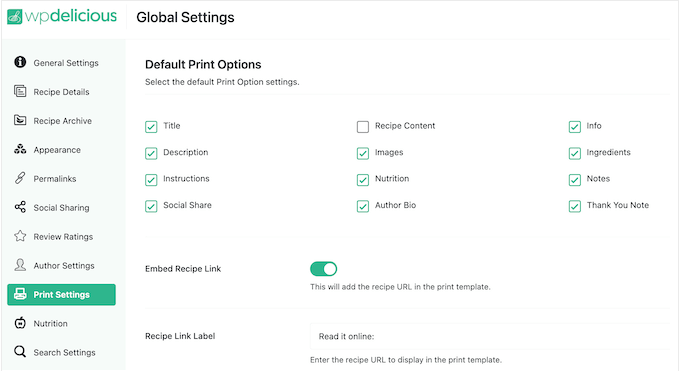
21. Überrasch mich Funktion
Manche Leser haben vielleicht kein bestimmtes Rezept im Sinn. In diesem Fall werden Sie sich freuen zu erfahren, dass WP Delicious eine "Überraschen Sie mich"-Funktion hat, die zufällig ein Rezept lädt. Dies ist eine unterhaltsame Möglichkeit für Besucher, neue Essensideen zu entdecken.
Sie können diese Funktion zu jedem Beitrag, jeder Seite oder Navigationsmenü hinzufügen.
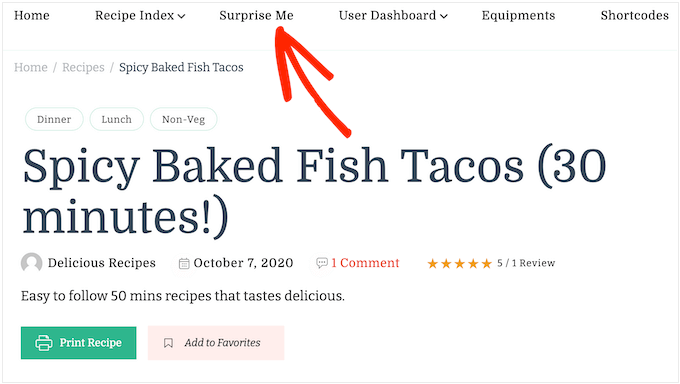
22. Unterstützt Benutzerregistrierung und Bewertungen
WP Delicious verfügt über ein einfaches Benutzerregistrierungs- und Anmeldesystem, das es den Lesern ermöglicht, ein Konto zu erstellen und dann auf vielfältige Weise mit Ihren Inhalten zu interagieren.
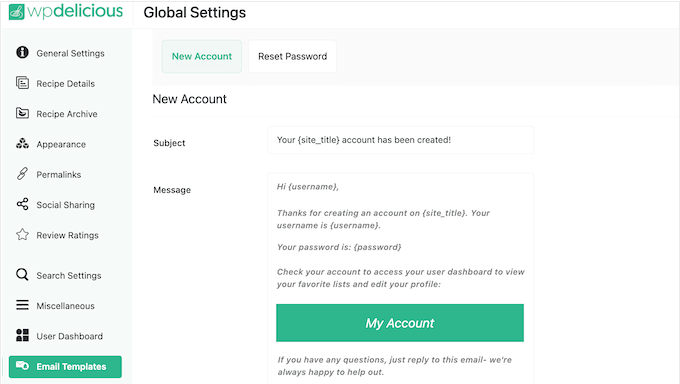
Zunächst können registrierte Benutzer Emojis posten und Ihre Rezepte zu ihrer Favoritenliste hinzufügen.
Sie können diese „Favoriten“-Seite jederzeit aufrufen, sodass diese Rezepte immer leicht zugänglich sind.
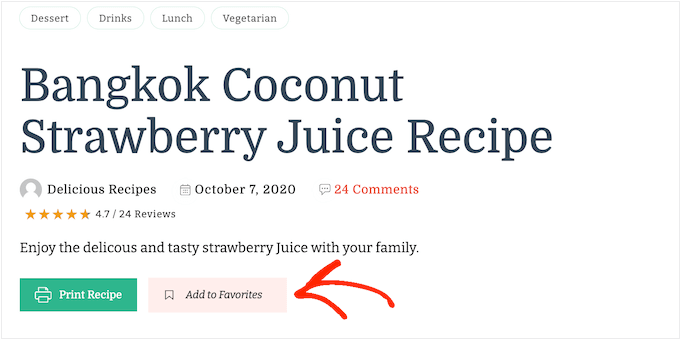
Darüber hinaus können registrierte Benutzer Ihren Rezepten eine Sternbewertung geben. Auf diese Weise können Sie sehen, welche Rezepte die Leser bevorzugen, und dann mehr von diesen Inhalten erstellen.
Im Hintergrund bezieht WP Delicious diese Bewertungen und Rezensionen in seine Rezept-Schema-Daten ein, sodass sie in relevanten SERPs erscheinen und Ihren Rezepten mehr Glaubwürdigkeit verleihen können.
Benutzer können auch Fragen zu Ihren Rezepten stellen und ihre eigenen Fotos hochladen. WP Delicious kann Ihnen helfen, ein Gemeinschaftsgefühl aufzubauen, das Engagement zu steigern und Besucher dazu zu bewegen, immer wieder auf Ihre Website zurückzukehren.
23. Benutzerdefinierte Rezepte akzeptieren
Möchten Sie Benutzereinsendungen auf Ihrer Website akzeptieren? WP Delicious verfügt über ein Rezept-Einreichungsformular, damit Besucher Rezepte schreiben und zur Veröffentlichung senden können.
Sie können diese Einreichungen in Ihrem WordPress-Dashboard anzeigen, Änderungen vornehmen und die besten auf Ihrer Website veröffentlichen. Jedes Mal, wenn Sie ein vom Benutzer eingereichtes Rezept veröffentlichen, benachrichtigt WP Delicious den Gastautor per E-Mail.
Dieses Formular funktioniert sofort oder Sie können es anpassen, um genau die Informationen zu sammeln, die Sie von den Lesern benötigen.
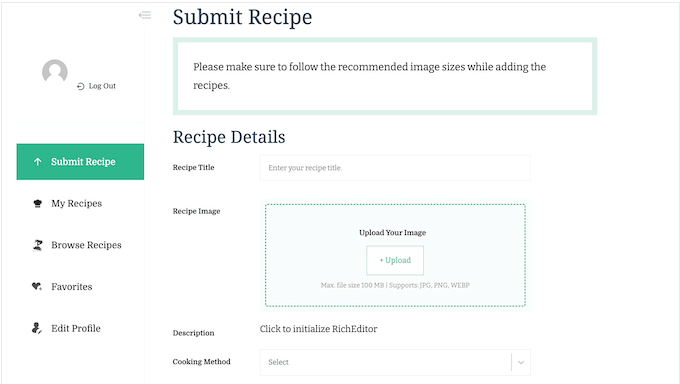
24. Google reCaptcha-Unterstützung
Spam-Registrierungen können ein großes Problem für Mitgliederseiten, Blogs mit mehreren Autoren und jede Website sein, auf der Sie Benutzerregistrierungen zulassen.
In diesem Sinne werden Sie sich freuen zu erfahren, dass WP Delicious Google reCaptcha (V2 oder V3) zu seinen Registrierungs- und Rezeptübermittlungsformularen hinzufügen kann.
Dies kann dazu beitragen, Ihre Website vor Spam-Registrierungen und spammigen Rezeptbeiträgen zu schützen.
25. Integriertes Analyse-Dashboard
Wenn Sie Ihre Website zu einem erfolgreichen Projekt oder Online-Geschäft ausbauen wollen, müssen Sie wissen, was Ihr Publikum mag.
WP Delicious verfügt über integrierte Analysen, die die Gesamtzahl der Likes, Favoriten und Bewertungen für jedes Rezept anzeigen. Es werden auch Ihre beliebtesten, am besten bewerteten und bevorzugten Rezepte hervorgehoben. Sie können diese Erkenntnisse dann nutzen, um mehr Inhalte zu erstellen, die die Leser lieben.
26. Unterstützung für Affiliate-Marketing
Affiliate-Marketing ist eine beliebte Methode, um online mit WordPress zu bloggen Geld zu verdienen. Sie könnten zum Beispiel auf eine bestimmte Marke eines elektrischen Mixers verlinken und jedes Mal eine Provision verdienen, wenn jemand über diesen Link einen Kauf tätigt.
Die gute Nachricht ist, dass WP Delicious Affiliate-Links zu Ihren Rezeptkarten hinzufügen kann, damit Sie Ihre Inhalte monetarisieren können.
Wenn Sie Affiliate-Links verwenden, gibt es in vielen Ländern Gesetze, die die Nichtoffenlegung bezahlter Empfehlungen regeln. In den Vereinigten Staaten könnten Sie beispielsweise eine Geldstrafe von der Federal Trade Commission erhalten. Sie könnten sogar von seriösen Netzwerken wie Amazon-Affiliates ausgeschlossen werden.
Wenn Sie Affiliate-Links verwenden, kann WP Delicious automatisch eine Affiliate-Offenlegung zu Ihrer Rezeptseite oder Ihrem Ausrüstungsbereich hinzufügen. Geben Sie einfach den gewünschten Text ein und wählen Sie aus, wo dieser Haftungsausschluss erscheinen soll, und WP Delicious kümmert sich um den Rest.
27. Community- und professionelle Unterstützung
WP Delicious verfügt über eine unkomplizierte Benutzeroberfläche, mit der Sie Rezepte über einen speziellen Editor erstellen können. Alternativ können Sie Rezepte im Handumdrehen mit der Dynamic Recipe Card und dem Standard- WordPress-Blockeditor erstellen.
Möglicherweise benötigen Sie jedoch zusätzliche Hilfe, um die erweiterten Funktionen des Plugins freizuschalten. In diesem Sinne gibt es eine Online-Dokumentation, auf die Sie rund um die Uhr zugreifen können.
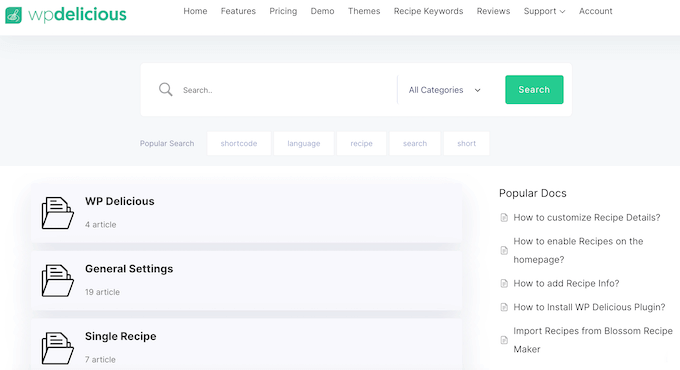
WP Delicious bietet auch eine Reihe von Video-Tutorials zu Themen wie der Erstellung von Rezepten mithilfe von benutzerdefinierten Beitragstypen und der Anzeige von Rezepten auf Ihrer benutzerdefinierten Homepage.
Wenn Sie das kostenlose Plugin verwenden, können Sie im WP Delicious-Forum auf WordPress.org posten und Antworten auf grundlegende Fragen erhalten.
Wenn Sie in öffentlichen Support-Foren posten, ist es immer eine gute Idee, so viele Informationen wie möglich anzugeben, damit die Experten Ihr Problem vollständig verstehen und eine hilfreiche Antwort posten können. Weitere Informationen zu diesem Thema finden Sie in unserem Leitfaden zur richtigen Anfrage nach WordPress-Support.
Bevorzugen Sie persönliche Unterstützung? Alle Premium-Pläne von WP Delicious beinhalten professionellen Support, sodass Sie ein Ticket einreichen und direkt von den Experten Hilfe erhalten können. Laut ihrer Website bemüht sich das WP Delicious-Team, alle Fragen bis zum nächsten Werktag zu beantworten.
WP Delicious Testbericht: Preise und Pläne
Wenn Sie gerade erst anfangen oder ein begrenztes Budget haben, können Sie die Lite-Version von WP Delicious kostenlos herunterladen. Dieses Plugin ermöglicht es Ihnen, eine unbegrenzte Anzahl von SEO-freundlichen Rezepten zu erstellen, komplett mit Galerien, Sternebewertungen und Social-Sharing-Symbolen.
Wenn Sie jedoch Leserbeiträge akzeptieren oder andere erweiterte Funktionen freischalten möchten, müssen Sie auf das Premium-Plugin upgraden.
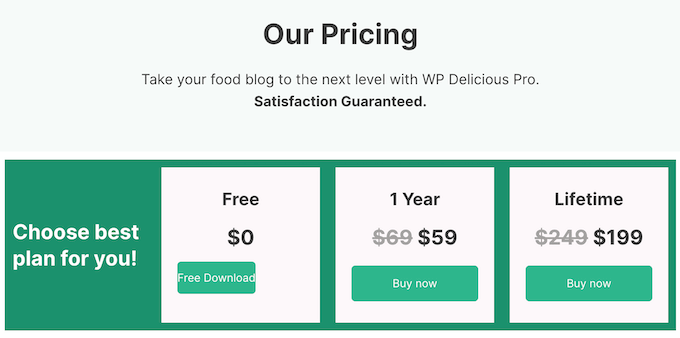
Sie können entweder eine Jahreslizenz für 59 $ oder eine lebenslange Lizenz für 199 $ erwerben. Beide Pläne erlauben Ihnen, WP Delicious auf einer einzelnen Website, einem Blog oder einem Online-Shop zu installieren.
Die Premium-Pläne beinhalten auch 8 Rezeptkarten-Layouts, integrierte Analysen, einen Abschnitt „Ähnliche Rezepte“ und weitere erweiterte Funktionen.
WP Delicious Test: Ist es das richtige Rezept-Plugin für Sie?
Nach Betrachtung der Funktionen, des Supports und der Preise sind wir zuversichtlich, dass WP Delicious ein großartiges Rezept-Plugin ist. Es ermöglicht Ihnen, eine unbegrenzte Anzahl professionell aussehender Rezepte zu erstellen, die detaillierte Schritt-für-Schritt-Anleitungen, Bilder, Videos und Lightbox-Popups enthalten.
Sie können auch Zutaten- und Ausrüstungslisten erstellen und sogar Geld verdienen, indem Sie Affiliate-Links zu Ihren Rezeptkarten hinzufügen.
Darüber hinaus kann WP Delicious Benutzerregistrierungsformulare und Rezept-Einreichungsformulare zu Ihrer Website hinzufügen. Dies ermöglicht es Ihnen, benutzergenerierte Inhalte zu akzeptieren und diese Rezepte auf Ihrer WordPress-Website zu veröffentlichen.
We hope this WP Delicious review helped you decide whether it’s the right recipe plugin for you. Next, you may want to see our guide on how to create a custom Instagram photo feed, or check out our expert pick of the best web push notification software.
Wenn Ihnen dieser Artikel gefallen hat, abonnieren Sie bitte unseren YouTube-Kanal für WordPress-Video-Tutorials. Sie finden uns auch auf Twitter und Facebook.



WP Delicious Nutzerbewertungen
Bitte teilen Sie Ihre WP Delicious-Bewertung, um anderen in der Community zu helfen.